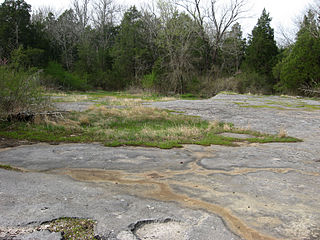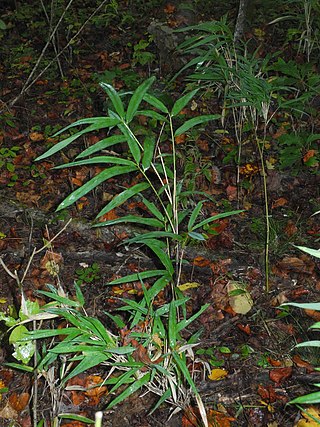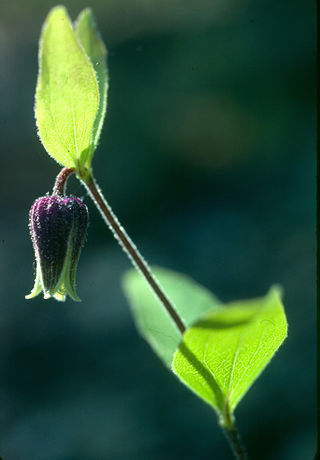
The Appalachian Mountains, often called the Appalachians, are a mountain range in eastern to northeastern North America. Here, the term "Appalachian" refers to several different regions associated with the mountain range, and its surrounding terrain. The general definition used is one followed by the United States Geological Survey and the Geological Survey of Canada to describe the respective countries' physiographic regions. The US uses the term Appalachian Highlands and Canada uses the term Appalachian Uplands..

Arundinaria is a genus of bamboo in the grass family the members of which are referred to generally as cane. Arundinaria is the only bamboo native to North America, with a native range from Maryland south to Florida and west to the southern Ohio Valley and Texas. Within this region Arundinaria canes are found from the Coastal Plain to medium elevations in the Appalachian Mountains.

Isoetes lacustris, the lake quillwort or Merlin's grass, is a boreal quillwort native on both sides of the northern Atlantic Ocean. Synonyms include Isoetes hieroglyphica.

White spruce is a common name for several species of spruce (Picea) and may refer to:

Xerophyllum asphodeloides is a North American species of flowering plants in the Melanthiaceae known by the common names turkey beard, eastern turkeybeard, beartongue, grass-leaved helonias, and mountain asphodel. It is native to the eastern United States, where it occurs in the southern Appalachian Mountains from Virginia to Alabama, and also in the Pine Barrens of New Jersey.

A calcareous glade is a type of ecological community that is found in the central Eastern United States. Calcareous glades occur where bedrock such as limestone occurs near or at the surface, and have very shallow and little soil development. Due to the shallow soil and the extreme conditions created by it, trees are often unable to grow in the glades. This creates a habitat that is usually sunny, dry, and hot. Calcareous glade vegetation is more similar to that of a desert habitat than a grassland, being dominated by small spring annuals with occasional geophytic or succulent perennials.
Ice Mountain is a mountain ridge and algific talus slope that is part of a 149-acre (60 ha) preserve near the community of North River Mills in Hampshire County, West Virginia, United States. It was designated a National Natural Landmark in 2012.

Arundinaria appalachiana, commonly known as hill cane, is a woody bamboo native to the Appalachian Mountains in the southeastern United States. The plant was elevated to the species level in 2006 based on new morphological and genetic information and was previously treated as a variety of Arundinaria tecta. The shortest member of its genus, hill cane ranges from 0.4–1.8 meter tall with a habit ranging from diffuse to pluri-caespitose. It is one of only three temperate species of bamboo native to North America. Hill cane is common on dry to mesic sites on upland slopes, bluffs and ridges in oak-hickory forests, which distinguishes it from other species in the genus: Arundinaria gigantea typically appears along perennial streams, while Arundinaria tecta is found in swamps and other very wet areas.

The Great Balsam Mountains, or Balsam Mountains, are in the mountain region of western North Carolina, United States. The Great Balsams are a subrange of the Blue Ridge Mountains, which in turn are a part of the Appalachian Mountains. The most famous peak in the Great Balsam range is Cold Mountain, which is the centerpiece of author Charles Frazier's bestselling novel Cold Mountain.

Isoetes engelmannii is a species of aquatic plant in the family Isoetaceae. It is referred to by the common names Engelmann's quillwort or Appalachian quillwort, and is the most widely distributed species of its genus in eastern North America. Its range extends from Ontario in the north, south to Florida and west Arkansas and Missouri. It can be found from April to October in temporary pools, bogs, marshes, stream edges, swamps and along wet roadsides.
Isoetes valida, commonly known as the strong quillwort or true quillwort, is an aquatic lycophyte native to eastern North America. It is found primarily in the Appalachian Mountains from Pennsylvania south to Alabama and Georgia. In addition, one collection of the plant was made in a railway ditch in Wilmington, Delaware in the 1860s, but this was most likely an accidental introduction.

Isoetes melanospora, commonly known as black-spored quillwort or black-spored Merlin's grass, is a rare and endangered aquatic lycophyte endemic to the U.S. states of Georgia and South Carolina.

Packera paupercula is a flowering plant species of the genus Packera and family Asteraceae, native to North America, where it is widespread across Canada and much of the United States. Its common names include balsam ragwort and balsam groundsel. It is a perennial herb that grows 1–3 feet tall. Its habitats include wet meadows, open woodlands, and rocky outcrops.

Clematis viticaulis is a species of flowering plant in the buttercup family known by the common names Millboro leatherflower and grape clematis.
Isoetes caroliniana, common name Carolina quillwort, is a wetlands plant native to the mountains of Tennessee, North Carolina, Virginia and West Virginia. It is an emergent plant found in lakes and bogs. It is closely related to I. georgiana but can be distinguished by its unpigmented sporangium wall.
Isoetes × eatonii, or Eaton's quillwort, is a hybrid between I. engelmannii and I. tenella. It can be found in ponds and slow moving rivers in Canada or in several New England states. In Canada, it has only been found in the Severn River in Ontario. In the United States, it has been found in Pennsylvania, New Jersey, and New York. It bears 12-100 long yellowish green leaves, each fine, soft, and 8 to 45 centimeters long. The unspotted tan colored sporangium are 12 millimeters long and 5 millimeters wide. The velum covers a sixth to a quarter of the sporangium. The elongated ligule is 3.5 millimeters long. The flattened white megaspores are 320 to 530 micrometers in diameter and bear short spiny ridges. The round microspores are 22 to 25 micrometers long.
Appalachian quillwort is a common name for several plants and may refer to:

Arundinaria tecta, or switchcane, is a bamboo species native to the Southeast United States, first studied in 1813. It serves as host to several butterfly species. The species typically occurs in palustrine wetlands, swamps, small to medium blackwater rivers, on deep peat in pocosins, and in small seepages with organic soils. The species is only known to occur in the Atlantic Plain, Gulf Coastal Plain, and Mississippi Embayment, though it was earlier thought to exist in the Piedmont and Southern Appalachians as well. Specimens from the uplands are now thought to be a separate but morphologically similar species, Arundinaria appalachiana.

Vittaria appalachiana, or the Appalachian shoestring fern, is a fern species in the subfamily Vittarioideae of the family Pteridaceae. It is native to moist and shaded outcrops in the Appalachian Mountains. It is notable for existing only in the gametophyte stage of development, unlike other fern species in which the sporophyte stage predominates. The species reproduces asexually through gemmae.













